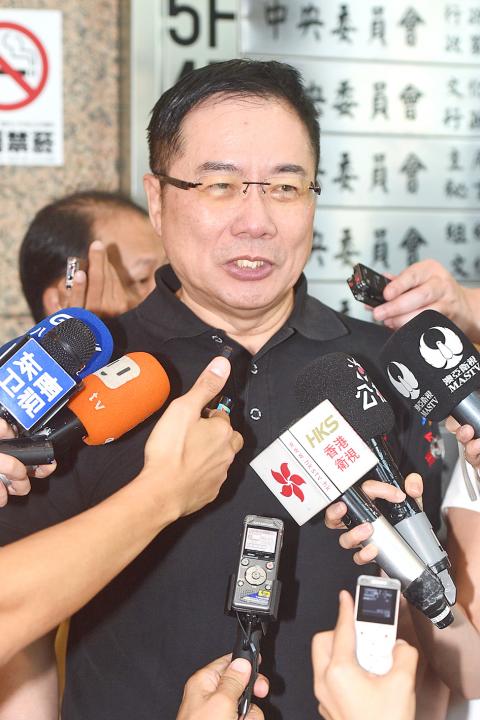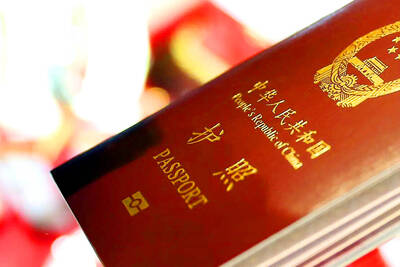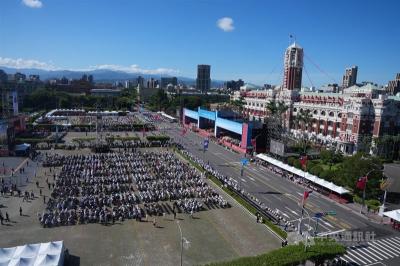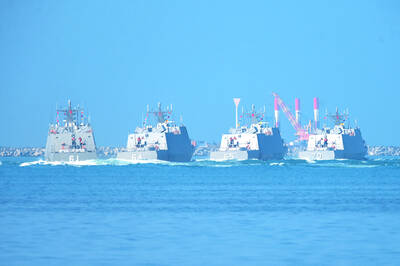Chinese Nationalist Party (KMT) Vice Chairman Hau Lung-bin (郝龍斌) yesterday urged KMT members to present a united front on the so-called “1992 consensus,” and cease the internecine conflicts that have driven a wedge between the camps of KMT Chairwoman Hung Hsiu-chu (洪秀柱) and former president Ma Ying-jeou (馬英九).
“In the past, the KMT’s cross-strait policy, which centers on adherence to the ‘1992 consensus’ and the ‘one China, with different interpretations’ framework, had only been challenged by the Democratic Progressive Party [DPP] and former president Lee Teng-hui (李登輝). Never before has it be a subject of contention within the KMT,” Hau said on Facebook.
With the approach of the Cross-Strait Peaceful Development Forum — which is scheduled to take place on Wednesday and Thursday next week in Beijing — it is critical that KMT members put forward a clear policy position and stop quarreling, the former Taipei mayor said.

Photo: George Tsorng, Taipei Times
The DPP’s difficulties over its stance on cross-strait relations demonstrate that the KMT’s cross-strait policy has been correct all along and that the “1992 consensus” and “one China, different interpretations” are vital to maintaining stable cross-strait development, Hau said.
“If even our own people reject that policy, we could lose the possibility of proving ourselves right through the failure of the DPP’s governance,” he said.
The “1992 consensus” refers to a tacit understanding between the KMT and Beijing that both sides of the Taiwan Strait acknowledge there is “one China,” with each side having its own interpretation of what “China” means. Former Mainland Affairs Council chairman Su Chi (蘇起) in 2006 said that he had made up the term in 2000.
At the center of the altercation between Hung’s and Ma’s camps is the policy platform passed by the party’s national congress early last month that aims to “further” the “1992 consensus” and explore the possibility of signing a cross-strait peace accord.
Critics have said the new platform is an attempt by Hung to move the KMT closer to the concept of “one China, same interpretation,” as it only mentions the “different interpretations” aspect of the “consensus” once in the introduction as part of the party’s history and omits the term in the latter part of the platform, which sets out the party’s main policy.
Hau said that without having a united front on the “1992 consensus” and “one China, different interpretations” the KMT would be in no position to question the DPP’s cross-strait policy or promote interactions across the Taiwan Strait.
“Also, how can we discuss a peace accord [with Beijing] if there is no consensus among Taiwanese and our position is not based on the foundation of ‘one China, different interpretations?’” Hau said.
Despite Hau’s calls for party solidarity, KMT Central Policy Committee director Alex Tsai (蔡正元) later yesterday took aim at Ma’s office, which issued a statement on Tuesday urging Tsai to study history more closely to gain a “more accurate understanding” of the content of the “1992 consensus.”
“Who is ‘Ma Ying-jeou’s office’ anyway? It published a weird news release without leaving the name of its spokesperson. It is no different from a fake Facebook account,” Tsai said on Facebook, urging the office to look at itself in the mirror before giving him directions.

The Ministry of the Interior (MOI) is to tighten rules for candidates running for public office, requiring them to declare that they do not hold a Chinese household registration or passport, and that they possess no other foreign citizenship. The requirement was set out in a draft amendment to the Enforcement Rules of the Public Officials Election and Recall Act (公職人員選舉罷免法 ) released by the ministry on Thursday. Under the proposal, candidates would need to make the declaration when submitting their registration forms, which would be published in the official election bulletin. The move follows the removal of several elected officials who were

The Republic of China (ROC) is celebrating its 114th Double Ten National Day today, featuring military parades and a variety of performances and speeches in front of the Presidential Office in Taipei. The Taiwan Taiko Association opened the celebrations with a 100-drummer performance, including young percussionists. As per tradition, an air force Mirage 2000 fighter jet flew over the Presidential Office as a part of the performance. The Honor Guards of the ROC and its marching band also heralded in a military parade. Students from Taichung's Shin Min High School then followed with a colorful performance using floral imagery to represent Taiwan's alternate name

FOUR DESIGNATED AREAS: Notices were issued for live-fire exercises in waters south and northwest of Penghu, northeast of Keelung and west of Kaohsiung, they said The military is planning three major annual exercises across the army, navy and air force this month, with the navy’s “Hai Chiang” (海強, “Sea Strong”) drills running from today through Thursday, the Ministry of National Defense said yesterday. The Hai Chiang exercise, which is to take place in waters surrounding Taiwan, would feature P-3C Orion maritime patrol aircraft and S-70C anti-submarine helicopters, the ministry said, adding that the drills aim to bolster the nation’s offshore defensive capabilities. China has intensified military and psychological pressure against Taiwan, repeatedly sending warplanes and vessels into areas near the nation’s air defense identification zone and across

A Chinese takeover of Taiwan would severely threaten the national security of the US, Japan, the Philippines and other nations, while global economic losses could reach US$10 trillion, National Security Council Deputy Secretary-General Lin Fei-fan (林飛帆) wrote in an article published yesterday in Foreign Affairs. “The future of Taiwan is not merely a regional concern; it is a test of whether the international order can withstand the pressure of authoritarian expansionism,” Lin wrote in the article titled “Taiwan’s Plan for Peace Through Strength — How Investments in Resilience Can Deter Beijing.” Chinese President Xi Jinping’s (習近平) intent to take Taiwan by force